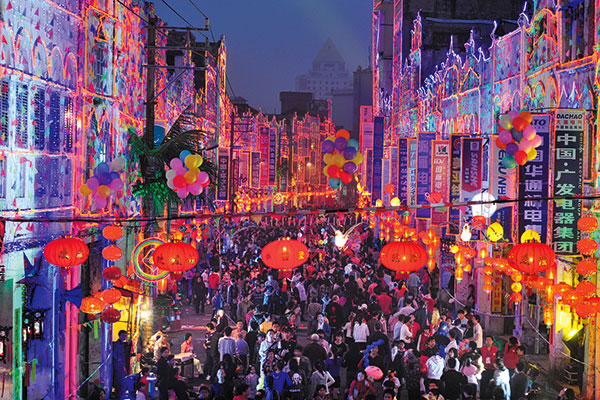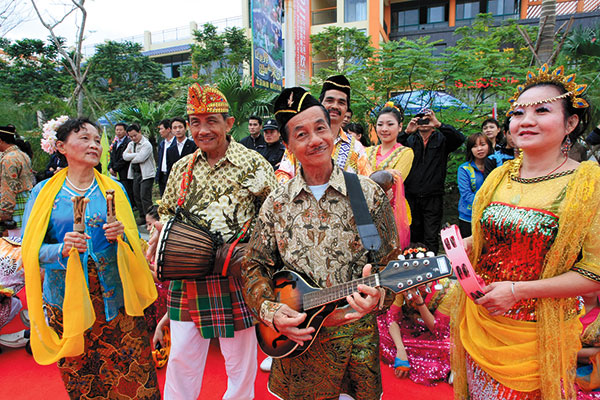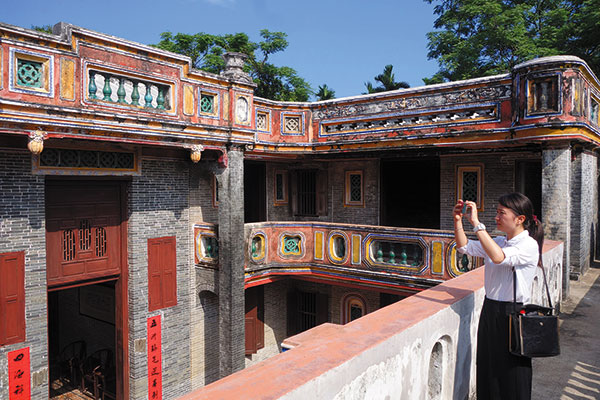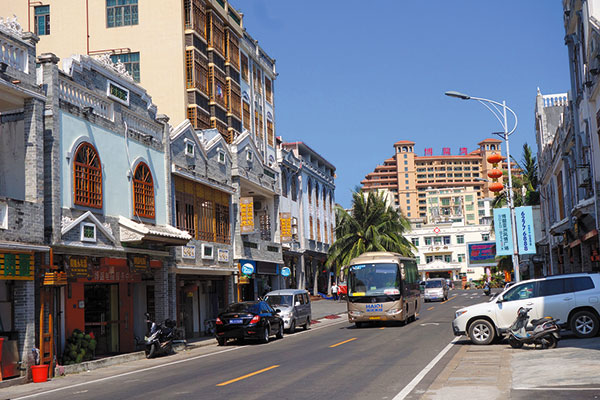
A popular street in Haikou that features the architectural style called qilou.[Photo by Huang Yiming/China Daily]

Chinese returnees from Southeast Asia perform in the town of Xinglong.[Photo by Huang Yiming/China Daily]
During the Ming and Qing Dynasties (1368-1911), a large proportion of Chinese ventured into Nanyang-the term for Southeast Asian countries and regions such as Malaysia, the Philippines and Indonesia-to carve out a living. Some returned, bringing back not only a variety of goods but the architectural styles of their far-flung adopted homes.
Many Chinese who returned to Hainan province were influenced by an architectural form they called qilou, or arcade houses. The style was widely used throughout Southeast Asia and melds several European architectural designs.
In Hainan province, the facade of a building built in the qilou style appears both exotic and very Chinese, with dragons, phoenix and auspicious flowers engraved into the frontage.
The province’s first qilou building was built in the shop-lined Bo’ai North Street in Haikou, capital of Hainan.
In Haikou, there are about 600 qilou buildings concentrated on 12 streets that stretch for 1.2 square kilometers. Built by Chinese returnees after the Qing Dynasty (1644-1911), it is the largest cluster of preserved qilou buildings in China.
In 2010, the 12 streets underwent renovations. One such thoroughfare, Zhongshan Street, is now open to the public and is a popular local tourist attraction.
Another area of Hainan where qilou buildings can be found is Qionghai, the home of many overseas Chinese who returned to the mainland.
A castle-like building in the town of Boao in Qionghai, nicknamed “the top house”, was built in 1934 by four brothers surnamed Cai who lived and made a fortune in Indonesia.
The mansion comprises two main buildings at the center and two twostory buildings on each side and courtyards at the front and back. It has 50 rooms, 80 doors and 104 windows and sits on an area of more than 600 square meters. The Cai family home is currently a tourist hotspot in Qionghai.
The town of Zhongyuan in Qionghai is another area that consists of Chinese returnees who once lived in Nanyang.
They not only brought back the exotic architectural styles of Southeast Asia, but also many of their goods, such as coffee. Today, many locals in Hainan brew their coffee in big iron kettles and drain it through cotton fabric or iron filters.
Coffee arrived in Hainan in the 1940s when Chinese Indonesian Chen Xianzhang introduced robusta coffee beans to the Fushan area of Chengmai county in northern Hainan. In southeastern Hainan, the town of Xinglong has more than 30 coffee shops that offer authentic Southeast Asian snacks.
Xinglong Overseas Chinese Farm is the largest farm for overseas Chinese in China. Since the 1950s, more than 13,000 overseas Chinese from 21 different countries and regions have relocated to the farm. Most of them speak foreign languages and some have still retained the lifestyle and customs of Southeast Asian countries.
Across the province, people like to gather in coffee shops and chat for a long time. There is even a nickname for this kind of leisure time: “old daddy’s tea”, a phrase that originated from Chinese returnees who once lived in Nanyang.
According to historical records, Hainan witnessed two waves of immigration out of China. One occurred during the Ming Dynasty (1368-1644), after the explorer Zheng He commanded expeditions to Southeast Asia, the Middle East and East Africa from 1405 to 1433. The other wave occurred in the Qing Dynasty after the first Opium War ended in 1842.
Figures from the Collection of Historical Documents Concerning Emigration of Chinese Laborers show more than 240,000 Hainan natives went abroad between 1876 and 1898. Today, about 2 million Hainanese live in Southeast Asia.
Xing Yixi, whose father went to Thailand as a teenager, said he currently lives 20 days of every month in China, with the rest of the time in Thailand. Xing first went back to Hainan in 2003 and invested 6 million yuan ($967,200) to build a road in his father’s name.
Chinese people’s experiences moving to Nanyang early last century have been adapted into Hainan local Qiong Opera.
Venturing into Nanyang, for example, has been critically acclaimed in China since the performance was held at the Mei Lanfang Theatre in Beijing in 2009.

The castle-like building that once belonged to the Cai family is a hotspot in Qionghai.[Photo by Huang Yiming/China Daily]

The town of Boao in Qionghai.[Photo by Huang Yiming/China Daily]
